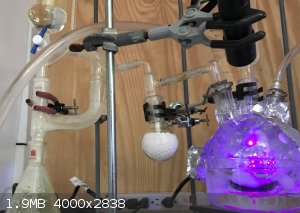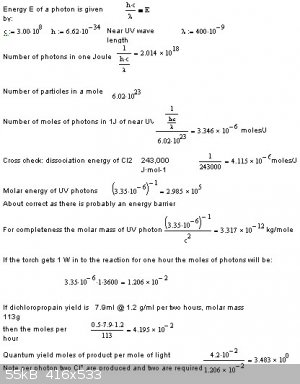Meltonium
Hazard to Self
 
Posts: 97
Registered: 23-9-2016
Location: Home in pajamas
Member Is Offline
Mood: Fluorinated
|
|
Chlorination of Natural Gasses
I attempted a free radical chlorination of natural gas from a 10lb propane tank (I've been very interested in free radical reactions lately) to see if
I could get a substantial liquid product from two gasses.
The picture attached is my setup. On the left side is my chlorine generator using TCCA in the Erlenmeyer and HCl in the addition funnel. Just right of
that is a flask filled with CaCl2 to dry the chlorine. That is connected to a three-necked RBF with a condenser on top (though the uv flashlight is
blocking it in this shot) and on the right side of the RBF a gas adapter leads to a 1/2psi pressure regulator connected to a propane tank off camera.

First, I flooded the reaction vessel with the natural gas (I really didn't want a chlorine fire), turned on the uv light, and then I started the
generation of the chlorine. Soon thereafter, a liquid started to condense in the condenser and drip down into the flask. The RBF warmed up to 27C when
the ambient temperature was 10C. The flask was placed in ice water to control the temperature. After about 1 hour, I covered the back half of the RBF
wil aluminum foil in hope to reflect the uv light back in the flask and get a higher reaction rate. After a total of two hours, the propane gas was
stopped and chlorine generation subdued. In the RBF, 7.9mL of a straw-colored liquid that fumes in air had been collected. It came out to weigh 9.68g
giving a density of 1.2g/mL. I think some of the product was carried out by the constant stream of gas in the RBF.
Initially during the reaction, I had thought the major product would be 2-chloropropane, or possibly 1-chloropropane. However, both of these have
densities far less than what was measured. I now think the products are more likely to be dichloropropanes which have densities near 1.2g/mL.
I think this experiment could be improved by adding some way to measure and control the flow of the natural gas and the chlorine. In this way, there
would be some control of the products being produced. In addition, a more intense uv light could be used along with a more efficient condenser.
Note: The natural gas contained in the canister has an SDS stating it is
87.5-100% Propane
0-7% Ethane
0-5% Propylene
0-2.5% Butanes
0-50ppm Ethyl Mercaptan
Because the only goal of this experiment was to collect the product, I rate this as a success. In the future, I plan to find a way to collect a pure
product or purify products from the mixture. I am open to any suggestions by the community.
|
|
|
Magpie
lab constructor
    
Posts: 5939
Registered: 1-11-2003
Location: USA
Member Is Offline
Mood: Chemistry: the subtle science.
|
|
Interesting. Why do you think it fumes? Dissolved HCl? What wattage light did you use? I reported on making carbon tet from chloroform this way.
The single most important condition for a successful synthesis is good mixing - Nicodem
|
|
|
Maroboduus
Hazard to Others
  
Posts: 257
Registered: 14-9-2016
Location: 26 Ancho Street
Member Is Offline
Mood: vacant
|
|
Sounds like part of the problem might be the 1-chloro product ends up getting re-chlorinated because with its low boiling point there's always plenty
of vapor in the flask even with ice cooling.
If you had a dean stark trap (the kind with the valve on the collection arm), you could put it between the flask and condenser and it would catch the
condensate so you could tap it off and put it somewhere away from the chlorine.
But if there's dissolved HCL in there as Magpie suggests, then maybe that's a big part of the extra density and you don't have that much of an over
chlorination problem. Maybe you could wash it with some ice cold base and re-weigh it?
I assume the condenser was ice cooled. Was the condenser output run to a vapor trap? If so, what kind and did it work well?
[Edited on 24-11-2016 by Maroboduus]
|
|
|
Dr.Bob
International Hazard
    
Posts: 2658
Registered: 26-1-2011
Location: USA - NC
Member Is Offline
Mood: No Mood
|
|
Likely mixture of mono, di, and maybe tri and tetra substituted products. In industry, they might make a mix and just distill off the components to
sell. If they only want one isomer, often they will do chemistry which can be better controlled than radical chlorination, but that is still a
practical way to make mixtures. Part of the issue is that borosilicate absorbs a large amount of the UV light, so a quartz reactor will improve the
yield dramatically, or any way to generate more UV light in the actual reaction. Simple sunlight is high in UV, just running the reaction outside
with a quartz tube would work to some degree, the longer the tube, the better.
I would also guess that Magpie is correct, the halogenated propane will likely dissolve some HCl, easy to fix by washing the product with some sat'd
bicarb soln, to remove that, or storing it over K2CO3. The next step would be distilling it, via even a short vigreux will allow you to watch the BP
over time and try to estimate what isomers you have made. The best way to test the mix would be by CG-MS, that would allow you to see how many
different things you have made. Maybe you can find someone nearby with one, many universities and even commercial labs have one.
|
|
|
Meltonium
Hazard to Self
 
Posts: 97
Registered: 23-9-2016
Location: Home in pajamas
Member Is Offline
Mood: Fluorinated
|
|
Quote: Originally posted by Magpie  | | Interesting. Why do you think it fumes? Dissolved HCl? What wattage light did you use? I reported on making carbon tet from chloroform this way.
|
Yes, I think the most probable reason it fumes is because of dissolved HCl. The light I used is just a cheap flashlight I found on Amazon. https://www.amazon.com/gp/product/B01DB885NG/ref=oh_aui_deta...
It doesn't have a wattage listed in it.
The dean stark trap is a good idea; I'll try that in the future as well as washing the product in a weak base and then storing over carbonate. I did
not have a gas trap because the condenser I used female joint broke off a while back so I have nothing to connect it to. Next time I will use an
unbroken condenser and connect it to a gas trap.
I will distill it as soon as I get back from Thanksgiving vacation and record the bps here. I will also check with my university about the CG-MS and
see how much it will cost.
[Edited on 24-11-2016 by Meltonium]
[Edited on 24-11-2016 by Meltonium]
|
|
|
Meltonium
Hazard to Self
 
Posts: 97
Registered: 23-9-2016
Location: Home in pajamas
Member Is Offline
Mood: Fluorinated
|
|
Quote: Originally posted by Dr.Bob  |
I would also guess that Magpie is correct, the halogenated propane will likely dissolve some HCl, easy to fix by washing the product with some sat'd
bicarb soln, to remove that, or storing it over K2CO3. |
I returned from my Thanksgiving vacation to find the color had disappeared from the solution. I suspect there may have been some photo-decomposition.
I proceeded by washing the mixture with a saturated sodium bicarbonate solution and then storing is over anhydrous magnesium sulfate to remove the
water contamination. After that, the density was measured to be 1.3g/mL.
That's a ridiculous measurement... Perhaps some of the sulfate dissolved in it, or the HCl could have been lowering the density?
Also, I don't have any quartz tubing, but I do have flint glass; could that work to replace borosilicate?
[Edited on 28-11-2016 by Meltonium]
|
|
|
Dr.Bob
International Hazard
    
Posts: 2658
Registered: 26-1-2011
Location: USA - NC
Member Is Offline
Mood: No Mood
|
|
Mag sulfate will not dissolve in organics, that is why it is used. Likely the lower MW components just evaporated, they are low boiling, so they will
go away with time.
Flint glass is worse than borosilicate - it absorbs more UV. The thinner the glass the better, so this is a place to use a think glass flask.
|
|
|
wg48
National Hazard
   
Posts: 821
Registered: 21-11-2015
Member Is Offline
Mood: No Mood
|
|
Wow I am suprised this can be done with UV LED flash light. They are only near uv and low power. I would have assumed a mercury vapour +100w tube
would be required and a quartz window.
I guess the chain reaction is long so the quantum yield is many times greater than one.
|
|
|
wg48
National Hazard
   
Posts: 821
Registered: 21-11-2015
Member Is Offline
Mood: No Mood
|
|
I was curious as to how many moles say one joule of UV would be. So I calculated it. Its 3.35 umoles of photons for IJ of 400nm UV. One watt for an
hour would be 0.012 moles.
I also calculated quantum yield using the given yield data and assuming 1w in to the flask. The result was 3.5 ( moles of product per mole of
photons)
One watt of UV into the flask and absorbed is probably a very unrealistic for AAA battery powered torch. If an optimistic 10mw is assumed the
quantum yield 350. So one UV photon produces 350 molecules of dichlorpropain. Not bad for a chain reaction. Perhaps its an overlooked method.
I have attached a screen cut of the calculation.
If you spot an error or want to comment feel free.

|
|
|